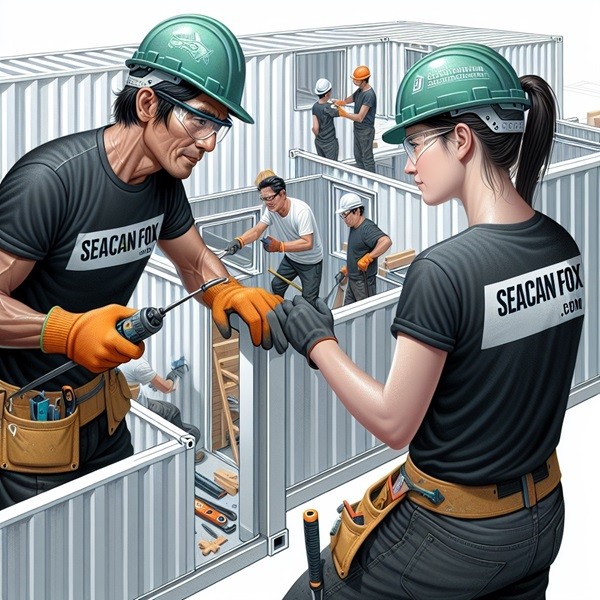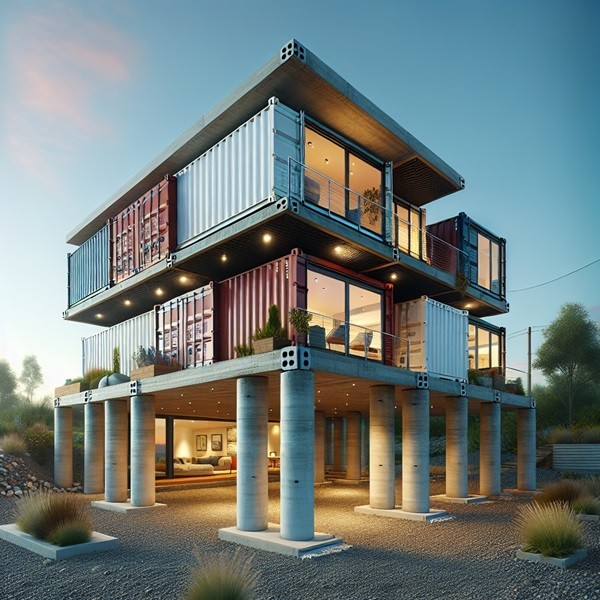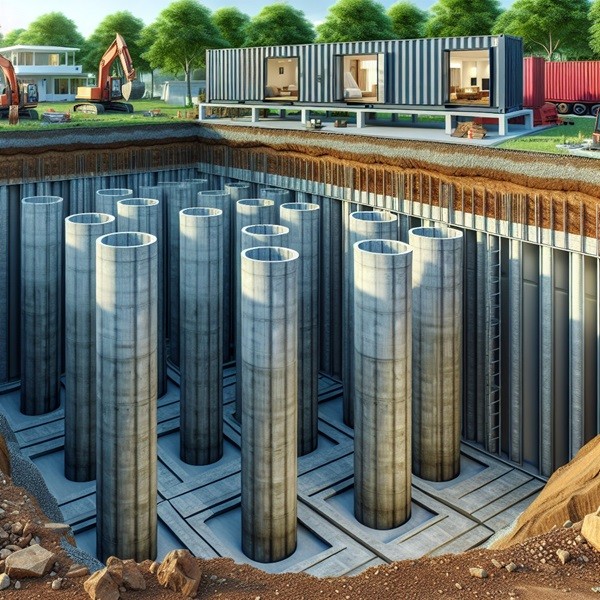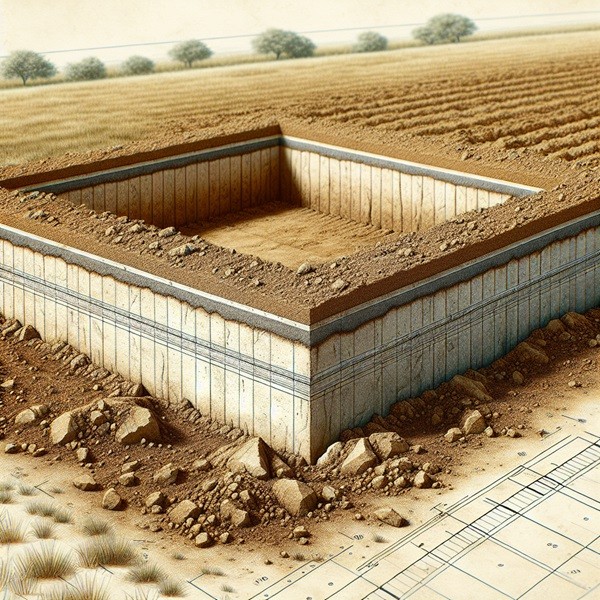
Key Takeaways
- Pier foundations are cost-effective and ideal for uneven terrains.
- Pile foundations provide deep, sturdy support, particularly in soft soil conditions.
- Slab foundations offer a solid, seamless base, suitable for areas with a high water table.
- Strip foundations give continuous support and are excellent for linear structures.
- Understanding local building codes and climate considerations is essential when choosing a foundation for your container home.
Table of Contents
My Favorite Container Homes Resource
I compared the top 3 Container Home Guides
to discover the ultimate resource!
See my top recommendation here
Laying the Ground Rules for Container Homes
Before diving into the types of foundations, let’s establish why a strong base is non-negotiable. A foundation does more than just support a structure; it connects your home to the ground in a way that manages a myriad of environmental factors. It’s about balancing the home on the site, protecting it from moisture, and providing
Why Foundations Matter
Imagine your container home as a ship not just by design, but in its need to navigate the seas of soil it rests upon. The ground beneath our feet isn’t as solid as it seems; it expands, contracts, and shifts. A foundation anchors the home, countering these movements to prevent damage. Furthermore, it elevates the structure to protect against flooding and pests. Most importantly, it ensures that your investment stands the test of time.
Types of Foundations at a Glance
There’s no one-size-fits-all when it comes to foundations for shipping container homes. You’ll need to consider factors like soil type, climate, and local building codes. Here’s a quick overview of the most common types:
- Pier Foundations: A series of concrete pillars that elevate and support the container.
- Pile Foundations: Deep-set cylindrical tubes capped with concrete, ideal for soft or unstable soil.
- Slab Foundations: A thick, flat concrete pad that provides a uniform base for the container.
- Strip Foundations: Continuous concrete footings that support the container along its perimeter.
Each type has its own set of pros and cons, which we’ll explore in detail to help you make an informed decision.
Pier Foundations: Elevated Support

Pier foundations are a popular choice for shipping container homes, particularly when dealing with uneven terrain or when you want to minimize the impact on the land. They involve the placement of concrete piers at strategic points beneath the container, which can be adjusted to level the home perfectly.
What Pier Foundations Are
At their core, pier foundations consist of concrete columns that are set deep into the ground, providing a sturdy base for the container to rest upon. These piers are typically connected by beams to distribute the weight evenly, and they offer several advantages:
- They minimize the amount of excavation required.
- They can be adapted to various ground conditions.
- They allow for easy access to utilities that run underneath the home.
Think of pier foundations as stilts that keep your home above any potential trouble on the ground.
When to Choose Pier Foundations
You might opt for pier foundations if your building site is on a slope or if you want to leave a minimal footprint on the land. They’re also a smart choice if you’re on a tight budget, as they can be less expensive than other foundation types. But remember, they’re not suitable for every scenario. If the soil is too soft or if you’re in a high wind area, you might need a different type of foundation.
Evaluating Pier Foundations for Container Homes
When considering pier foundations, you need to assess several factors:
- The load-bearing capacity of the soil.
- The height and weight of your container home.
- Accessibility for construction equipment.
- Local climate conditions, such as freeze-thaw cycles.
These considerations will help you determine the size and spacing of the piers, as well as the depth to which they should be set.
Pile Foundations: Deep Support

Pile foundations can be a choice for shipping container homes, especially on uneven terrain or when minimizing land impact is essential. They entail the installation of concrete piles strategically beneath the container, which can be adjusted to ensure perfect alignment.
What Pile Foundations Are
Essentially, pile foundations comprise concrete columns driven deep into the ground to provide a stable base for the container. These piles are typically interconnected by beams to distribute weight evenly, offering several benefits:
- They reduce the need for extensive excavation.
- They can be tailored to various ground conditions.
- They facilitate easy access to utilities passing beneath the home.
Think of pile foundations as sturdy supports lifting your home above potential ground issues.
When to Opt for Pile Foundations
Pile foundations are suitable if your building site is sloped or if you aim to minimize land disturbance. They’re also cost-effective, making them a prudent choice for those on a tight budget. However, they may not be suitable for all situations; softer soil or high wind areas may require alternative foundation types.
Assessing Pile Foundations for Container Homes
When considering pile foundations, several factors must be evaluated:
- Soil’s load-bearing capacity.
- Container home’s height and weight.
- Accessibility for construction machinery.
- Local climate conditions, including freeze-thaw cycles.
These factors guide decisions regarding pile size, spacing, and depth to ensure a stable foundation for your container home.
Slab Foundation: Solid and Seamless

Now, let’s talk about slab foundations. These are essentially a single layer of thick concrete that is laid directly on the ground. This slab acts as the sole foundation for your container home, providing a sturdy and uniform base that’s both practical and cost-effective in the right circumstances.
The Basics of Slab Foundations
A slab foundation is like the flatbed of a truck; it provides a stable, level area for your shipping container home. Constructed correctly, it’s a solid chunk of concrete that can protect against moisture and vermin. Plus, it’s a great thermal mass, which means it can help regulate the temperature inside your home.
Slab Foundations for Container Homes
Choosing a slab foundation for your container home could be a smart move, especially if you’re in an area with a high water table where other types of foundations might be problematic. Slabs are also a good pick if you’re planning a permanent structure and don’t intend to move your home in the future.
Pros and Cons of Slab Foundations
There are clear benefits to choosing a slab foundation, such as:
- It’s typically less expensive than a basement foundation.
- It reduces the risk of flooding and pest infestation.
- It can be quicker to install than other types of foundations.
However, there are also some drawbacks to consider:
- It offers no under-home storage or access to utilities.
- It requires precise preparation and pouring to avoid cracks.
- It can be difficult to repair sewer lines once the slab is poured.
Strip Foundation: Continuous Support

Moving on to strip foundations, which are a bit like the continuous footing of a traditional house. They involve a long strip of concrete that’s laid beneath the perimeter of the container home, providing a continuous base of support.
Understanding Strip Foundations
Strip foundations are trenches filled with concrete that form a continuous loop under the edges of your container. They’re especially useful when you’re placing your home on softer soils that need a little extra support spread out along the length of the structure.
Strip Foundations in Container Home Construction
For container homes, strip foundations offer a happy medium between stability and cost. They’re more substantial than pier foundations but less so than a full slab. This makes them a versatile choice for many container homeowners.
Advantages and Limitations of Strip Foundations
Strip foundations come with their own set of advantages:
- They’re great for supporting the linear structure of container homes.
- They help distribute the weight of the home evenly.
- They can be less expensive than full slab foundations.
But there are limitations as well:
- They can be more expensive and labor-intensive than pier foundations.
- They may not be suitable for all soil types.
- Like slab foundations, they don’t allow for under-home access.
Picking the Perfect Base for Your Container Home
Choosing the right foundation for your shipping container home is a balancing act. You’ll need to weigh the benefits of each type against the specific needs of your build site and personal preferences.
Factors to Consider
When deciding on a foundation, keep these key factors in mind:
- The topography of your land.
- The soil type and bearing capacity.
- Climate conditions and the risk of natural disasters.
- Your budget and the intended use of your container home.
- Local building codes and regulations.
Foundation Types for Container Homes
| Foundation Type | Benefits | Estimated Cost |
|---|---|---|
| Pier | Cost-effective and ideal for uneven terrains[3][4] Minimal land impact[1] DIY friendly and requires no special expertise or equipment[4] |
$550 |
| Pile | Provide deep, sturdy support, particularly in soft soil conditions[2] Ideal for challenging soils[2] |
Varies |
| Slab | Offer a solid, seamless base, suitable for areas with a high water table[2] Pest protection[2] |
$5400 |
| Strip | Give continuous support and are excellent for linear structures[2] Weight distribution[5] |
$5400 |
References:
Expert Tips for Selection
Here’s what I recommend:
- Consult with a local engineer or architect who understands the soil conditions and building codes in your area.
- Consider the long-term implications of your choice, including potential maintenance issues and resale value.
- Don’t skimp on the foundation. A little extra investment upfront can save you a lot of trouble down the line.
Ultimately, the foundation you choose should align with your vision for your home, the characteristics of your building site, and your budget. Remember, a solid foundation is not just the base of your home; it’s the platform for your future.
Building Codes and Compliance
It’s not enough to pick a foundation type based on preference alone; you must also navigate the world of building codes and compliance. These regulations are in place to ensure safety and are not to be taken lightly. Ignoring them can lead to costly fines and even the demolition of non-compliant structures.
Navigating Regulations for Container Homes
Every region has its own set of building codes, and it’s crucial to familiarize yourself with these before you begin construction. These codes cover everything from the depth of your foundation to the materials you can use. They also address how your home must be anchored to the foundation to withstand wind and seismic activity. Because shipping container homes are a relatively new concept, you may encounter zoning officials who are unfamiliar with them. It’s your responsibility to provide detailed plans that demonstrate code compliance.
Ensuring Your Foundation Meets the Standards
To ensure your foundation is up to code, you should:
- Obtain a copy of the local building codes and study them thoroughly.
- Work with a certified engineer or architect who has experience in container home construction.
- Submit detailed plans to your local building department for approval before construction begins.
- Consider hiring a building inspector to review the foundation work at various stages of the construction process.
Meeting these standards is not just a legal requirement; it’s a way to protect your investment and ensure the longevity and safety of your home.
Frequently Asked Questions (FAQ)
As you embark on your journey to build a shipping container home, you may have some questions. Let’s address some of the most common inquiries:
Can Shipping Container Homes Be Built on Any Foundation?
While shipping container homes are versatile, they can’t be built on just any foundation. The foundation must be designed to support the weight and structure of the container. Factors such as soil type and climate also play a crucial role in determining the appropriate foundation.
How Does Climate Influence the Choice of Foundation?
Climate has a significant impact on the type of foundation you choose. For instance, in areas with a high risk of flooding, a raised foundation like piers might be best. In regions with cold climates, a foundation that extends below the frost line can prevent shifting during freeze-thaw cycles.
Are Shipping Container Home Foundations More Affordable Than Traditional Ones?
Generally, the foundations for shipping container homes can be more affordable due to their smaller size and the reduced need for extensive excavation and materials. However, costs can vary widely based on the type of foundation and local labor rates.
What Is the Lifespan of a Shipping Container Home Foundation?
The lifespan of a shipping container home foundation can be comparable to that of traditional homes if constructed properly. With adequate maintenance and depending on the type, a foundation can last anywhere from 50 to over 100 years.




